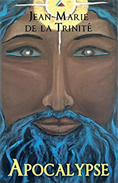
 |
Apocalypse Trinity 8: Journey of Atonmemnon to the Plains of Peace
by Jean-Marie de la Trinité
CreateSpace Independent Publishing Platform
Combining an electric writing style with unparalleled devotion for the Lord, the author unleashes a fury of vivid metaphors that will undoubtedly leave an indelible mark in the reader’s mind. From the outset, the author establishes a distinctly sublime, mystical tone that demonstrates God’s existence in all forms, be it under the acacia tree, the love of a father, or in the fiery glance of the sun.
As Rain, the main character, reflects upon the elements of life and the behavioral tendencies of mankind, he is tasked with bringing humanity out of despair and to the mountain of God. In the process, the author uses Rain’s perspective to weave an intricate narrative that embeds extensive spiritual reflection. Specifically, the dialogue between the spiritual guide and the young boy in “Mystical Colloquy” presents a discussion that holds applicable, thought-provoking discussions about how to follow in the path that God has outlined for each individual. At the core of his lessons, the guide dwells on many elements of meditation and spirituality, focusing specifically on the act of prayer and being still in order to peer within the body and into the soul. Introspection, he believes, only comes once the incessant pendulum of thoughts in the mind can be laid to rest. In many ways, the conversation between the young boy and the spiritual guide is reminiscent of the epic discussion on dharma conducted on the battlefield between the Hindu god Lord Krishna and his wavering disciple, the warrior Arjuna, which ultimately formed the fabric of the Bhagavad Gita.
Throughout the text, the author’s depth of research and comprehensive knowledge of world cultures, including references to Isis and Osiris—Egyptian deities—is on full display. The author tackles spirituality through mysticism, which allows the individual to grasp the full impact of words like humility, trust, and love—the only way to true atonement. The mystique the author so successfully creates spawns from a resplendent imagination that illuminates the reader’s mind like a raging inferno in the night sky. From the seething jungle and peace being a flower to the wind turning into amber and “the grass to emerald,” imagery that will take respite in the minds of the readers is present on nearly every page. This is never more apparent than in one of the most harrowing scenes of the entire novel: death is lurking while mankind goes blind with ignorance, “the blind leading the blind, the dead following the dead.” In nearly every culture, such a scene exists where humanity has lost its way and no longer can see the light; the author’s on-point portrayal is certain to ignite conversation.
While the narrative is certainly an integral element of this epic, it is only one element. As the text progresses, the author shows his versatility by expressing themes like the Trinity and always being with God in spirit through epic poetry. Simultaneously, he embraces vulnerability by showcasing uncanny visions through diary entries spanning three years. The writing is fearless and authentic, both showcasing awakening with love as well as entries that open with statements about waking up in the depths of hell and encountering demonic visions. Taking time to navigate the layers of this work, particularly the figurative language, is imperative; many of the most profound sections can simply pass the reader by if he or she is not reading for the experience. Ultimately, this book is rooted in originality and depth of research, a stirring fusion of narrative, verse, scripture, and journaling—all wound together in the veil of mysticism and spirituality.
RECOMMENDED by the US Review